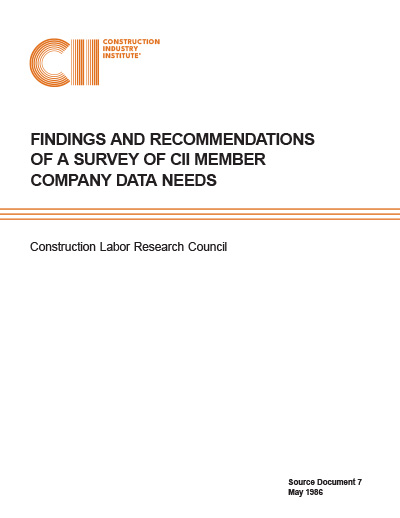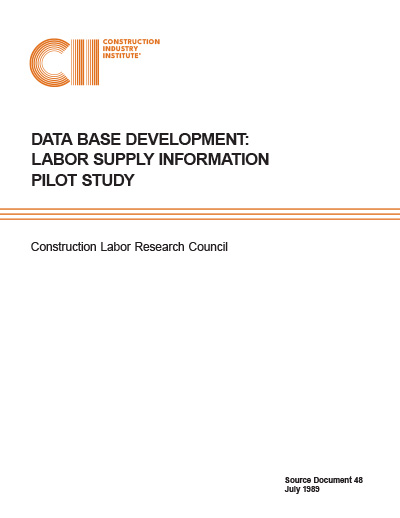
Findings and Recommendations of a Survey of CII Member Company Data Needs
The lack of reliable statistical information to measure and evaluate the state of the construction industry has long been recognized. The situation can impede a company's efforts to properly plan, budget and control its construction projects and, therefore, reduce the probability of decisions being made in the most cost effective manner. The problem was highlighted by the CICE project of The Business Roundtable which found “a bizarre lack of accurate information” relating to the industry.
To identify the subjects with the greatest information deficiencies, the Data Task Force of the Construction Industry Institute undertook a review of construction information sources. A group of CII member companies were requested to evaluate the data used within their organizations and their priorities as to data which are needed, but not now available. This report contains the findings of a survey of member company data needs. The report will be used as the basis of establishing a CII Construction Industry Statistics Program which will assist in meeting company and industry information needs.
The survey sought to identify data needs, but served as a reminder of the high degree of risk that is inherent in the construction industry. To the extent that information can be used to reduce the level of risk and uncertainty, it is valuable to companies. Clearly, the greatest data needs tend to arise when a company is preparing for an upcoming project for which it has few past experiences, either by type of project or geographic area. The Construction Industry Institute can best assist its member companies in meeting their data needs in two broad areas:
- Design and Implementation of a Local Area Data System – central access to a variety of data bases providing information on local factors which impact cost. The highest priorities are data identifying local craft wage rates and local craft labor availability.
- Develop Construction Cost Indexes/Projections – a family of indexes provide the inputs for each company to construct company indexes and project future cost changes.
A prerequisite for successfully implementing a data program will be a strong foundation of preparation to establish broadly supported definitions, standards, and scope for all data terms and data bases.
Recurring themes that were expressed and which are behind the findings and recommendations include some remaining apprehension, especially among contractors, in providing data to CII because of concerns about confidentiality. However, there was a general agreement to the need for data topics areas including: (SD-7, p. 7)
- Craft labor rates
- Labor availability
- Cost indexes
- Productivity
- Non-traditional work schedules
- Database of contractor experience
- Measurement of contract changes
The finding of the Construction Industry Cost Effectiveness Project of the Business Roundtable was that there is a lack of credible information available to define and monitor the construction industry has been confirmed and reinforced by the Data Task Force’s survey of CII member companies’ data needs. Member companies are most concerned by the lack of information available to assist them in planning and estimating upcoming projects. Therefore, it has been concluded that: (SD-7, p. 27)
- There is a demand for any data which can reduce risk and uncertainty before beginning a project
- There is widespread support for CII to meet this demand for data
Highest priority in developing databases should be given to these three types of information most requested and needed by member companies.
- Local craft wage rates, especially non-union
- Local craft labor availability, especially short-term
- Cost indexes for large projects of all types


